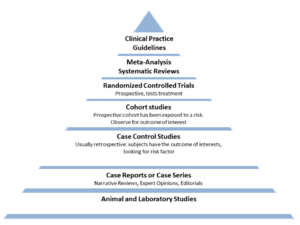Evidence Based Medicine, Hierarchy of evidence
Evidence Based Medicine[edit | edit source]
Evidence based medicine (EBM) is an approach to medical practice that consists of the use of results of documented previous research in order to treat patients in the most accurate and efficient way possible. Even though modern medicine is profoundly based on empirical (scientifically proven by experiment) facts, Evidence Based Medicine extends further, rating the findings from the experiments by different measures (for example, the number of people the trial was performed on, the randomness of the testing etc.).The results of randomized controlled trials and meta-analysis will be considered the strongest, most recommended evidence to rely on, while the researches that are less credible will be case-controlled studies or experiments with an unknown origin.
The main concept of evidence-based medicine is to prove that medical practice should not be based solely on the treating physician’s personal knowledge or experience but it should be more definitely based on solid, reliable, carefully gathered evidence.
When gathering medical evidence, the method of choice is the Scientific Method. It standardizes the gathering of evidence, regardless of the type of evidence, by following a strict set of steps. The goal of this method is to test a given theory (hypothesis).
Guidelines of Medical Based Medicine[edit | edit source]
EBM guidelines are essentially documents issued by respected medical society in the particular field (e.g. American Society of Hematology) that aim to guide decisions and criteria regarding practice, diagnosis, and decisions in various clinical instances. Modern medical guidelines are based on an examination of current evidence within the format of evidence-based medicine. Continuously updated, EBM Guidelines follows the latest developments in clinical medicine and brings evidence into practice.
Scientific databases[edit | edit source]
There is a huge amount of scientific evidence and the number is still increasing, therefore an abstracting and indexing services that serves for searching in the evidence have grown up in the last decades. The services are sometimes called scientific databases. The most important scientific databases and indexing services covering the field of medicine are following:
- Web of Science (Web of Knowledge) – general interest database
- Scopus – general interest database
- PubMed – medical database
- Medline – medical database
- Embase –medical database
Hierarchy of Medical Evidence and Evidence Pyramid[edit | edit source]
The hierarchy of medical evidence is the distinguishable levels of evidence that can be obtained through various methods, and placing them in an order based on their credibility.
- At the bottom of the pyramid there are lab testing and animal research. While this is not necessarily an optimal method in order to validate a certain therapy, it can be used as an indicator about the adverse effects of a treatment.
- In the middle of the evidence pyramid, there are case rontrol eports and case studies that outline treatment on patients, yet yield no verifiable evidence as they can only show causation, and not correlation. Furthermorusually e, case studies use past medical documents to retrospectively look for evidence as opposed to cohort studies which prospectively follows a large number of patients in an attempt to find an outcome.
- Randomized controlled trials (RCT) is a type of medical experiment which aims to reduce bias when testing a new treatment. The people participating in the trial are randomly allocated to either the group receiving the treatment under investigation or to a group receiving standard treatment (or placebo treatment) as the control.
- Systematic review is the Review of the RCTs or other high-evidence articles and is regarded as the key in evidence-based medicine.
- Meta-Analysis is the quantitative and statistical analysis of the results of several RCTs or other hi-evidence studies. All results are compared, and all corresponding results are put together statistically to reach more conclusions. The stronger correlation between different methods about one topic, for example the hearts response to a drug, the more likely it is to be true. This is the highest level of evidence.
Clinical trials - Types of clinical trials[edit | edit source]
Clinical trials are research studies that evaluate the efficiency of new medical approaches. A study might, for example, try to provide better ways to prevent, screen for, diagnose or treat a disease.
- Controled trial - the effect of the therapy is controlled by the control group (participants that do not recieve a treatment)
- Randomized CT - randomization means that the participants are assigned into the groups (treated vs. placebo goup) randomly. So the patient does not know if he/she is treated or not and therefore they are not able to influence the outcome. Placebo is a substance similar in appearance to the experimental drug ihat s used, not containing the active ingredients.
- Blinded, double blinded or tripple blinded CT - The participant or both the doctor and participant or all three the doctor, participant and statistician do not know how were the patients divided into the groups, so they do not know if the particular patient is in the treated group or in the placebo group
- Multi-center - a study is carried out in multiple locations (e.g. in different hospitals or even in more than one countries)


